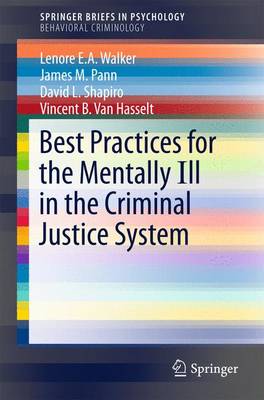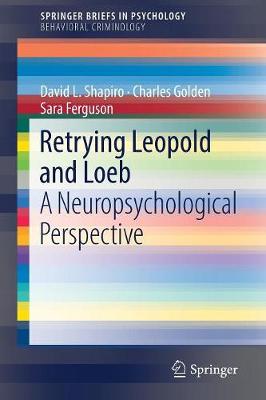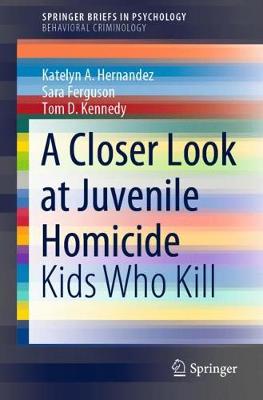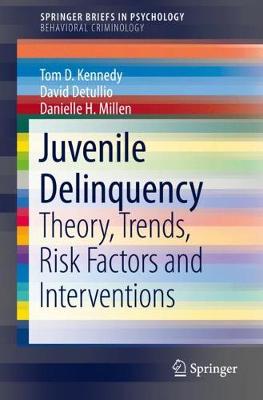SpringerBriefs in Psychology
4 total works
Best Practices for the Mentally Ill in the Criminal Justice System
by Lenore E.A. Walker, James M. Pann, David L. Shapiro, and Vincent B. Van Hasselt
This timely brief resource introduces a new evidence-based model for treatment of mentally ill individuals in jails, with emphasis on community-based options. Forensic mental health experts review police alternatives to arresting mentally ill persons in confrontations, the efficacy of problem-solving courts, and continuity of care between jail and community. The book's best-practices approach extends to frequently related issues such as addiction, domestic violence, juvenile considerations, and trauma and describes successful programs coordinating judicial and clinical systems. These guidelines for decriminalizing non-violent behaviors and making appropriate services available to those with mental problems should also help address issues affecting the justice system, such as overcrowding.
Included in the coverage:
- The Best Practices Model.
- Best practices in law enforcement crisis interventions with the mentally ill.
- Problem-solving courts and therapeutic jurisprudence.
- Competency restoration programs.
- A review of best practices for the treatment of persons with mental illness in jail.
- Conclusions, recommendations, and helpful appendices.
With its practical vision for systemic improvement, Best Practices Model for Intervention with the Mentally Ill in the Criminal Justice System is progressive reading for practitioners in the mental health field, especially practitioners working with inmates, as well as for stakeholders in the law enforcement and justice systems.
Retrying Leopold and Loeb
by David L. Shapiro, Charles Golden, and Sara Ferguson
This book retrospectively analyzes the notorious 1924 case of Leopold and Loeb, in which two college students murder a young boy just to prove they could do it. In the almost hundred years since that trial, the field of neuroscience along with neuropsychology have expanded tremendously, and there are now much more sophisticated tools that could be used to evaluate the perpetrators of this crime. Although deemed mentally ill at the time, there was not much scientific evidence that could be brought to bear on the defendants’ and their behavior. Now a legal psychologist and a neuropsychologist team up to tackle the case from a modern viewpoint. Using contemporary knowledge of the brain and behavior they map out the way the case might be handled today. Not just of historical interest, this volume serves as a case study for students and professionals alike, and a review of procedures used in such difficult cases.
A Closer Look at Juvenile Homicide
by Katelyn A. Hernandez, Sara Ferguson, and Tom D. Kennedy
This book focuses on the small but disturbing percentage of homicides by children that occur each year, providing a brief overview of the legal, individual, and social aspects of this phenomenon. Since the 1980s, these crimes have been on the rise and the resulting legal response has been harsher punishments as well as treatment of children like adults. This has led to a host of failures in the juvenile justice system wherein recidivism is high and general outcome is low. The book reviews the literature on youth homicide, including gender, age, and race factors, as well as individual, familial, and environmental risks. The authors seek to aid in the identification and understanding of juvenile homicide to raise awareness of both a population that receives little formal psychological intervention and of the systemic deficiencies that affect these individuals as well as society itself. Exploring current theories, trends, and common factors in juvenile homicide, this brief aims to improve prevention, intervention, and reintegration of young offenders into the community.
Juvenile Delinquency
by Tom D. Kennedy, David Detullio, and Danielle H. Millen
This brief explores the current theories, trends, risk factors, and intervention efforts related to juvenile crime. Although arrest rates for juveniles in the US have declined over the last two decades, the amount of severe crimes warrants increased examination as the US reports higher rates than most other developed countries. The authors examine individual, family, and environmental risk and protective factors for juvenile crime, while considering the need for better integration of treatment into critically at-risk areas of the community. Covering notable topics of interest for researchers and public policy makers alike, this brief provides an overview of factors and trends related to juvenile crime, aiming to support more effective, evidence-based treatment and prevention.



